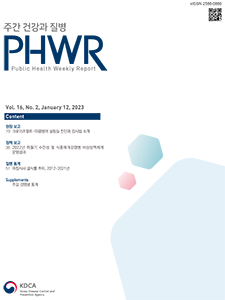Current Issue
Vol.16 No.2, January 12, 2023
-
Notes from the Field 2023-01-12
 0
0
 775
775
 127
127
Introduction of Laboratory Diagnosis and Examination of Creutzfeldt-Jakob Disease
Su Gwon Roh, Byoungchul Gill, Jun Young Kim, Jaeil Yoo*
Public Health Weekly Report 2023; 16(2): 19-35 https://doi.org/10.56786/PHWR.2023.16.2.1 Abstract
AbstractCreutzfeldt-Jakob disease (CJD) is an infectious prion disease caused by the accumulation of misfolded prion proteins in the central nervous system. It is associated cognitive impairment and ataxia, and results in death within several months after the onset. CJD is subdivided into sporadic, genetic, and acquired types according to the phenotype, epidemiological features, and pathogenesis. Laboratory diagnosis of CJD offers the advantage of being autopsy-free and is essential for accurate diagnosis of the disease along with assessment of clinical symptoms and electroencephalography. In addition, since the incidence of CJD is increasing worldwide, including in the Republic of Korea, the importance of laboratory diagnosis of the disease is also increasing. The 14-3-3 protein analysis, real-time quaking-induced conversion (RT-QuIC), prion protein (PRNP) gene mutation analysis are mainly used to diagnose CJD. Since each of these diagnostic tests has different interpretations and limitations, combined analysis is essential for the accurate diagnosis and classification of CJD. For efficient disease management, a diagnosis accompanied by simultaneous multilateral analysis using various laboratory diagnostics is indispensable in patients with suspected CJD.
-
Policy Notes 2023-01-12
 1
1
 866
866
 242
242
Results of the Food and Waterborne Disease Surveillance during the Summer in 2022
Da Seul Kim, Inho Kim, Hyungjun Kim, Ji Ae Shim, Jisu Won, Jin Gwak*
Public Health Weekly Report 2023; 16(2): 36-50 https://doi.org/10.56786/PHWR.2023.16.2.2 Abstract
AbstractThe Korea Disease Control and Prevention Agency operates an “Enhanced Surveillance of Food and Waterborne Disease (FWD) Outbreaks” from May 1 to September 30 every year based on reports of municipal, provincial, city and district health centers nationwide to respond quickly to mass outbreaks. The surveillance is used to prevent FWD in summer, when temperatures are expected to increase. During the operation of surveillance in the summer of 2022, in all, 300 outbreaks of FWD were reported; this number is in line with the pre-coronavirus disease 2 019 (COVID-19) number. The most outbreaks, 89 (29.7%), occurred in July 2022, followed by 70, 59, 45, and 37 outbreaks in June, May, August, and September, respectively. Regarding the regions in which outbreaks occurred, the majority were reported in Gyeonggi-do (61), Seoul (48), and Busan (27). Most outbreaks occurred in restaurants, followed by daycare centers and school facilities, including kindergarten facilities. Therefore, because the number of FWD in the summer of 2022 recovered to the pre-COVID-19 level, the management of diseases also needs to be as it was before COVID-19. Education on personal hygiene and safe water and food, and the efforts of managers and workers in group-catering facilities such as schools, workplaces, and restaurants, where there is a high risk of outbreaks, are important to prevent large-scale outbreaks of FWD.
-
QuickStats 2023-01-12
 0
0
 1656
1656
 466
466
The 2012–2021 Trends in Skipping Breakfast among Korean People
Public Health Weekly Report 2023; 16(2): 51-52 https://doi.org/10.56786/PHWR.2023.16.2.3

pp. 1433~1461
Most Keyword
?
What is Most Keyword?
- It is the most frequently used keyword in articles in this journal for the past two years.
Most Read
-
Waterborne and Foodborne Disease Outbreaks in the Republic of Korea, 2023
Myung-Jae Hwang, So Yeon Park, Hyungjun Kim, Se Jeong Yang, Sungchan Yang, Jin Seon Yang
Public Health Weekly Report 2025;18: 17-32 https://doi.org/10.56786/PHWR.2025.18.1.2 -
Implementation Plan for the Coronavirus Disease 2019 Vaccination for the 2024–2025 Season: Recommendations of the 6th Expert Committee on Immunization Practices
Hyewook Hwang, Wookeon Lee, Seohyeon Ahn, Young-Sook Choi, Seunghyun Lewis Kwon, Dongwoo Lee, Eun Hwa Choi, SokGoo Lee
Public Health Weekly Report 2025;18: 90-102 https://doi.org/10.56786/PHWR.2025.18.2.3
Editorial Office
+82-43-719-7569





 Full Text
Full Text Cite
Cite


